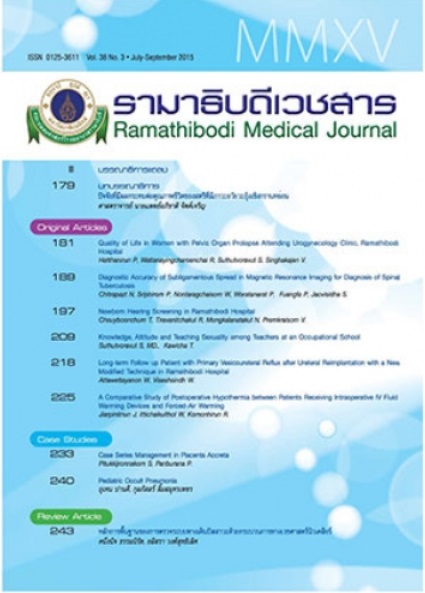A Comparative Study of Postoperative Hypothermia between Patients Receiving Intraoperative IV Fluid Warming Devices and Forced-Air Warming
Keywords:
Postoperative hypothermia, Operating room temperature, Forced-air warmingAbstract
Background: Patients undergoing surgery under anesthesia lead to increased risk of postoperative hypothermia and complications. One of the risk factors is the operating room temperature which effect body heat loss.
Objective: To compare the incidence of postoperative hypothermia in obstetric and gynecologic patients at Ramathibodi Hospital between patients receiving intraoperative IV fluid warming devices (study group: S) and forced-air warming alone (control group: C) in operating room temperature lower than 20°C.
Methods: A cross-sectional and randomized study was conducted in fifty-eight patients undergoing obstetric and gynecologic surgery under anesthesia during December 2013 to April 2014. Outcomes were analyzed and compared between patients group S and group C in a single operating room with the temperature lower than 20°C. The possible factors of postoperative hypothermia were collected body temperature in operating room (before, during and at the end of surgery) and in PACU (when admission and before discharge). Hypothermia is defined as a core body temperature of less than 36°C.
Results: Twenty-nine patients in each group were enrolled. Of these, mean age in group S and group C were 45.79 ± 14.23, 50.28 ± 10.28 years (p-value 0.175), mean body weight were 59.42 ± 15.78, 63.71 ± 15.0 kg (p-value 0.171), mean operating room temperature were 19.39 ± 0.76, 19.27 ± 1.13°C. (p-value 0.625), and the median of anesthetic time were 165, 135 min (p-value 0.624), the body temperature when admission at PACU were 36.22 ± 0.52 and 36.26 ± 0.57°C respectively (p-value 0.829). The overall incidence of postoperative hypothermia was 43.1% (n = 25), group S = 41.37% and group C = 44.83%. No incidence of postoperative hypothermia with the temperature of below 35°C.
Conclusion: The efficacy of intraoperative IV fluid warming devices with forced-air warming and pre-warmed fluids is comparable to forced-air warming with pre-warmed fluids for prevention of postoperative hypothermia.
References
Sessler DI. Temperature regulation and monitoring. In: Miller RD, Eriksson LI, Fleisher LA, Wiener-Kronish JP, eds. Miller’s Anesthesia. 7th ed. Philadelphia: Elsevier Churchill Livingstone; 2010:1533-36.
Frank SM. Consequences of hydrothermia. Curr Anaesth Crit Care. 2001;12:79-86.
Sessler DI. Complications and treatment of mild hypothermia. Anesthesiology. 2001;95:531-43.
Kurz A, Sessler DI, Lenhardt R. Perioperative normothermia to reduce the incidence of surgical wound infection and shorten hospitalization. N Eng J Med. 1996;334:1209-15.
Jiarpinitnun J. Ittichaikulthol W. Komonhirun R. Incidence of postoperative hypothermia in obstetric and gynecologic patients at Ramathibodi Hospital. Rama Med J. 2014;37:53-62.
Sessler DI. Mild perioperative hypothermia. N Engl J Med. 1997;336:1730-7.
Smith CE, Desai R, Glorioso V, Cooper A, Pinchak AC, Hagen KF. Preventing hypothermia: convective and intravenous fluid warming versus convective warming alone. J Clin Anesth. 1998;10:380-5.
Kaudasch G1, Schempp P, Skierski P, Turner E. The effect of convection warming during abdominal surgery on the early postoperative heat balance. Anaesthesist. 1996;45(11):1075-81.
Sessler DI. Temperature monitoring and perioperative thermoregulation. Anesthesiology. 2008;109:318-38.
Woolnough M, Allam J, Hemingway C, Cox M, Yentis SM. Intra-operative fluid warming in elective caesarean section: a blinded randomised controlled trial. Int J Obstet Anesth. 2009;18(4):346-51. doi:10.1016/j.ijoa.2009.02.009.
Pennsylvania Patient Safety Advisory. Prevention of inadvertent perioperative hypothermia. Pennsylvania: ECRI Institute and ISMP; 2008:5.
Carpenter L, Baysinger CL. Maintaining perioperative normothermia in the patient undergoing cesarean delivery. Obstet Gynecol Surv. 2012;67(7):436-46. doi:10.1097/OGX.0b013e3182605ccd.
Insler SR, Sessler DI. Perioperative thermoregulation and temperature monitoring. Anesthesiol Clin. 2006;24(4):823-37.
Oshvandi K, Shiri FH, Fazel MR, Safari M, Ravari A. The effect of pre-warmed intravenous fluids on prevention of intraoperative hypothermia in cesarean section. Iran J Nurs Midwifery Res. 2014;19(1):64-9.
Downloads
How to Cite
Issue
Section
License
Copyright (c) 2015 By the authors. Licensee RMJ, Faculty of Medicine Ramathibodi Hospital, Mahidol University, Bangkok, Thailand

This work is licensed under a Creative Commons Attribution-NonCommercial-NoDerivatives 4.0 International License.













